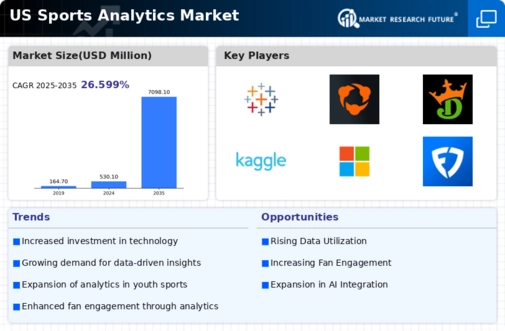Integration of Wearable Technology
The integration of wearable technology is significantly impacting the sports analytics market, as athletes and teams utilize devices to monitor performance metrics in real-time. Wearables such as smartwatches and fitness trackers provide valuable data on heart rate, speed, and other physiological parameters. This influx of data allows coaches and analysts to make informed decisions regarding training regimens and game strategies. The market for wearable technology in sports is expected to reach $5 billion by 2026, indicating a robust growth trajectory. Consequently, the sports analytics market is evolving to incorporate these technologies, enhancing the ability to analyze player performance and health.
Focus on Fan Experience Enhancement
The sports analytics market is also witnessing a focus on enhancing fan experience through data insights. Teams and organizations are utilizing analytics to better understand fan preferences and behaviors, leading to more personalized experiences. This includes tailored marketing strategies and improved engagement through interactive platforms. The market for fan engagement solutions is projected to grow significantly, with estimates suggesting a value of $3 billion by 2025. By leveraging analytics, teams can create more meaningful connections with their audiences, ultimately driving ticket sales and merchandise revenue. This emphasis on fan experience is likely to continue shaping the strategies of organizations within the sports analytics market.
Emergence of Advanced Statistical Models
The emergence of advanced statistical models is reshaping the landscape of the sports analytics market, as teams adopt sophisticated methodologies to analyze player and team performance. These models, which often incorporate machine learning algorithms, allow for more accurate predictions and insights. The application of such models is becoming increasingly prevalent in player evaluation and game strategy formulation. As teams strive for precision in their analyses, the demand for advanced statistical tools is expected to rise. This trend indicates a shift towards a more scientific approach in sports, further solidifying the role of analytics in decision-making processes within the sports analytics market.
Growing Demand for Performance Analytics
The sports analytics market is experiencing a notable surge in demand for performance analytics, driven by teams and organizations seeking to enhance player performance and optimize strategies. This trend is particularly evident in professional leagues, where franchises are increasingly investing in data-driven insights to gain a competitive edge. According to recent estimates, the market for performance analytics is projected to grow at a CAGR of approximately 25% over the next five years. This growth is fueled by advancements in technology, enabling teams to collect and analyze vast amounts of data. As a result, the sports analytics market is becoming an essential component of team management and strategy formulation.
Increased Investment in Data-Driven Decision Making
There is a marked increase in investment in data-driven decision making within the sports analytics market, as organizations recognize the value of leveraging data for strategic advantages. Teams are allocating substantial budgets to analytics departments, with some franchises reportedly spending upwards of $10 million annually on analytics initiatives. This investment is aimed at improving player recruitment, game strategy, and overall team performance. The trend suggests that organizations are prioritizing data as a critical asset, leading to a more analytical approach in sports management. As a result, the sports analytics market is likely to see continued growth as teams seek to harness the power of data.

















Leave a Comment